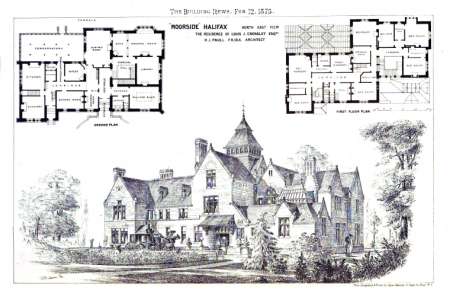“Moorside,” Skircoat Green, Halifax
“MOORSIDE,” HALIFAX - RESIDENCE OF LOUIS J. CROSSLEY, ESQ.- NORTH-EAST VIEW - The site of this house is suburban, and somewhat narrow and limited in extent, but commands a fine view of the valley towards Huddersfield and the hilly country around. It was first set apart by John Crossley, Esq., for the erection of a collegiate school, which was proceeded with under Mr. Paull's superintendence as far as the ground-floor story, and then abandoned. The architect was required to utilise the wrought masonry of the college (a large quantity) in the erection of this house, which occasioned a plain treatment externally. The walls are of brick, faced with pitch-faced wall stones, and all quoins and window and door dressings, etc., are of boasted stone from the best local quarries. The roofs are covered with Westmoreland slates. All the apartments are warmed by fresh, warm air, conveyed from a heating chamber in the basement by glazed earthenware pipes; and extraction of foul air is effected by gas through ventilators and tubes in the roofs. The columns between the drawing-room and ante-room are of Devonshire marble, supporting arches of pink alabaster, the spandrels of which are of open alabaster work. In the ante-room an organ has been erected with oak case, designed by the architect. The lodge and entrance gates are at the western end of the grounds, and a range of stabling has been erected on a plot of land a short distance apart. Complete telegraphic communication exists between the house and the lodge and stables, and with the Dean Clough Mills (John Crossley and Sons, Limited), which are situated on the opposite side of the town. The view shows the residence as originally designed. In execution, the lantern lights have been omitted. The height of the ground-floor principal rooms is 14ft. The whole of the works were carried out in 1870-2 by local contractors and tradesmen, under the superintendence of the architect, H. J. Paull, Esq., F.R.I.B.A., of Manchester. [Building News 12 February 1875 page 178]
Louis John, the son of John Crossley, was born in Wade Street, Halifax. He was first sent to school in London, lodging with a Congregational minister, but because of his delicate health, was brought back and educated at home by a tutor. At 17 years he started work at the bottom of the ladder in the wool department of the family mill, riding his horse down the hill to start work at 6am. His natural talent for mechanics was soon revealed and he became an authority on boilers and general machinery, eventually supervising that department. At the age of 19 he also became interested in electricity, and devoted many hours to studying it at a laboratory in the home of Mr John Waterhouse FRS at Well Head, Halifax. He was the first to introduce electric lighting on a practical scale to Halifax, importing from London the celebrated Gramme machine which had been used for lighting the Houses of Parliament. He demonstrated the electric light from a window in Harrison Road, (probably the Lit & Phil Soc, now Harrison House), and adopted the lighting at Albion Mills and Dean Clough. He used the same machine to demonstrate how sound could be conveyed by electricity, erecting a wire from his home at Manor Heath to Northowram Hall, and developing the Crossley-Brequet instrument to convey verbal messages between the mill buildings at Dean Clough. With his system in place, it was a simple matter to link into it the first telephone to be brought into the country, one of the early instruments made by Professor Graham Bell. Finding it inefficient, Louis John developed an improvement that amplified and clarified the sound, and in 1879 sold the patent of the Crossley Transmitter to the United Telephone Company for £20,000. During the experiments, an 8 mile wire had been erected from Square Church in Halifax to Saltaire, Bradford, demonstrating that the singing of the congregation could be heard with great clarity via the equipment at either end. His work in meteorology led to him being made a fellow of the Royal Meteorological Society.
Louis married in 1865, and built himself a large house, Moorside, in Stafford Road. The house was a maze of wires and scientific instruments; barometers, magnetic clocks, thermometers, a collection of deep sea cables, Twin Otto gas engines generating 10,000 candle power each, a wind gauge on the roof which transmitted readings to dials in the entrance hall, almost every room had some evidence of his consuming scientific interests. The drawing room contained a chamber organ with five keyboards and 16ft pipes in the cellar below. On the roof of the house a lighthouse with a high power lens revolved in its cast iron tower. Accurately focused, the beam from the lantern gave enough light to read a newspaper one and a half miles away! The house was also equipped with chemical and electrical laboratories, a large dynamo and generator with conduits under the floor for cables, resistance coils and all the equipment to generate electricity. Workshops contained a nine foot power lathe, milling machine etc, twin gas engine etc. A copper wire conveyed the current to Dean Clough, and a Gramme Machine fed overhead power lines in the grounds where, in collaboration with Mr Holroyd Smith, a pioneer electric tramcar was built and run on 150yds of line at a gradient of 1 in 25. In its two trucks, eight people could be pulled up the slope at 8mph. Crossley built an electric tramway in the gardens and a large electric organ in the drawing room. The billiard-room housed a collection of sections of submarine cables An electrical laboratory and a workshop were added later
